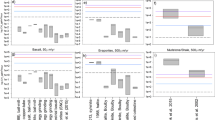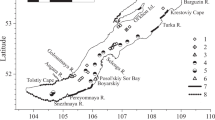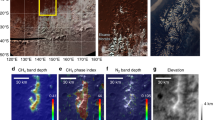Abstract
A strong, repeatable seasonal cycle in the background methane mixing ratio has been observed at the Gale Crater landing site of the Mars Science Laboratory rover with the Tunable Laser Spectrometer of the Sample Analysis at Mars instrument. However, as of yet, no physical process has been proposed that can explain both the timing and amplitude of the observations. Here we show that a one-dimensional numerical model considering adsorption onto and diffusion through the regolith can reproduce the variation, including a phase lag, if the regolith is impregnated with methane from a prior plume or supplied from below by microseepage. Combining the model results with geological constraints, we estimate that the amount of microseepage at Gale is at most 3 × 10−5 tonnes km−2 yr−1. Gale’s unique dynamical environment makes such seeps easier to detect in surface sampling measurements. Over most of the Martian surface, atmospheric mixing is stronger or atmospheric transport more effective, and we expect the amplitude of the seasonal cycle to be smaller for the same strength of seep.
This is a preview of subscription content, access via your institution
Access options
Access Nature and 54 other Nature Portfolio journals
Get Nature+, our best-value online-access subscription
$29.99 / 30 days
cancel any time
Subscribe to this journal
Receive 12 print issues and online access
$259.00 per year
only $21.58 per issue
Buy this article
- Purchase on Springer Link
- Instant access to full article PDF
Prices may be subject to local taxes which are calculated during checkout


Similar content being viewed by others
Code availability
The code used to generate the figures shown in this paper and in the Supplementary Information are available at www.yorku.ca/jmoores/MarsMethane1D.tar.gz and there are no restrictions on availability.
Data availability
All data used in this study, REMS and SAM-TLS values, are available on the Planetary Data System (https://pds.nasa.gov). For methane data, the reader is further directed to ref. 4 where reduced tabulated values are available. All other data used in the production of this paper are listed in the text, and the figures were generated from this data using the code described under Code availability.
References
IPCC Climate Change 2014: Synthesis Report (eds Core Writing Team, Pachauri, R. K. & Meyer, L. A.) (IPCC, 2014)
Haberle, R. M. K., Melinda, A., De la Torre, M., Kass, D. M. & Mars Science Laboratory Science Team. Detection of Northern Hemisphere transient baroclinic eddies in REMS pressure data at Gale Crater Mars. In American Astronomical Society, DPS Meeting 48 id.220.13 (2016).
Haberle, R. M. et al. Secular climate change on Mars: an update using one Mars year of MSL pressure data. In American Geophysical Union Fall Meeting 2014 abstr. P51B-3947 (2014).
Webster, C. R. et al. Background levels of methane in Mars’ atmosphere show strong seasonal variations. Science 360, 1093–1096 (2018).
Webster, C. R. & Mahaffy, P. R. Determining the local abundance of Martian methane and its’ 13C/12C and D/H isotopic ratios for comparison with related gas and soil analysis on the 2011 Mars science laboratory (MSL) mission. Planet. Space Sci. 59, 271–283 (2011).
Atreya, S. K., Mahaffy, P. R. & Wong, A.-S. Methane and related species on Mars: origin, loss, implications for life and habitability. Planet. Space Sci. 55, 358–369 (2007).
Oehler, D. Z. & Etiope, G. Methane seepage on Mars: where to look and why. Astrobiology 17, 1233–1264 (2017).
Mumma, M. J. et al. Strong release of methane on Mars in northern summer 2003. Science 323, 1041–1045 (2009).
Krasnopolsky, V. A., Maillard, J. P. & Owen, T. C. Detection of methane in the Martian atmosphere: evidence for life? Icarus 172, 537–547 (2004).
Formisano, V., Atreya, S., Encrenaz, T., Ignatiev, N. & Giuranna, M. Detection of methane in the atmosphere of Mars. Science 306, 1758–1761 (2004).
Geminale, A., Formisano, V. & Giuranna, M. Methane in Martian atmosphere: average spatial, diurnal, and seasonal behavior. Planet. Space Sci. 56, 1194–1203 (2008).
Geminale, A., Formisano, V. & Sindoni, G. Mapping methane in Martian atmosphere with PFS-MEX data. Planet. Space Sci. 59, 137–148 (2011).
Webster, C. R. et al. Mars methane detection and variability at Gale Crater. Science 347, 415–417 (2015).
Webster, C. R. et al. Low upper limit to methane abundance on Mars. Science 342, 355–357 (2013).
Vicente-Retortillo, A. et al. Determination of dust aerosol particle size at gale crater using REMS UVS and mastcam measurements. Geophys. Res. Lett. 44, 3502–3508 (2017).
Moores, J. E., Smith, C. L. & Schuerger, A. C. UV production of methane from surface and sedimenting IDPs on Mars in light of REMS data and with insights for TGO. Planet. Space Sci. 147, 48–60 (2017).
Martinez, G. M. et al. The modern near-surface Martian climate: a review of in-situ meteorological data from Viking to Curiosity. Space Sci. Rev. 212.1-2, 295–338 (2017).
Gough, R. V., Tolbert, M. A., McKay, C. P. & Toon, O. B. Methane adsorption on a Martian soil analog: an abiogenic explanation for methane variability in the Martian atmosphere. Icarus 207, 165–174 (2010).
Meslin, P.-Y., Gough, R., Lefèvre, F. & Forget, F. Little variability of methane on Mars induced by adsorption in the regolith. Planet. Space Sci. 59, 247–258 (2011).
Grotzinger, J. P. et al. A habitable fluvio-lacustrine environment at Yellowknife Bay, Gale Crater, Mars. Science 343, 1242777 (2014).
Stevens, A. H., Patel, M. R. & Lewis, S. R. Modelled isotopic fractionation and transient diffusive release of methane from potential subsurface sources on Mars. Icarus 281, 240–247 (2017).
Lasue, J., Quesnel, Y., Langlais, B. & Chassefière, E. Methane storage capacity of the early Martian cryosphere. Icarus 260, 205–214 (2015).
Hu, R., Bloom, A., Gao, P., Miller, C. E. & Yung, Y. L. Hypotheses for near-surface exchange of methane on Mars. Astrobiology 16, 539–550 (2016).
Newman, C. E. et al. Winds measured by the rover environmental monitoring station (REMS) during the Mars Science Laboratory (MSL) rover’s Bagnold Dunes Campaign and comparison with numerical modeling using MarsWRF. Icarus 291, 203–231 (2017).
Press, W. H., Teukolsky, S. A., Vetterling, W. T. & Flannery, B. P. Numerical Recipes in C: The Art of Scientific Computing 2nd edn (Cambridge Univ. Press, New York, 1992).
Rafkin, S. C. R. et al. The meteorology of Gale Crater as determined from rover environmental monitoring station observations and numerical modeling. Part II: interpretation. Icarus 280, 114–138 (2016).
Tyler, D. Jr. & Barnes, J. R. Mesoscale modeling of the circulation in the Gale Crater region: an investigation into the complex forcing of convective boundary layer depths. Mars 8, 58–77 (2013).
Moores, J. E. et al. Observational evidence of a suppressed planetary boundary layer in northern Gale Crater, Mars as seen by the Navcam instrument onboard the Mars Science Laboratory rover. Icarus 249, 129–142 (2015).
Moore, C. A. et al. A full Martian year of line-of-sight extinction within Gale Crater, Mars as acquired by the MSL Navcam through sol 900. Icarus 264, 102–108 (2016).
Lemmon, M. T. et. al. Dust devil activity at the Curiosity Mars rover field site. In 4 8th Lunar and Planetary Science Conference Contribution No. 1964, id.2952 (2017).
Moores, J. E. et al. Transient atmospheric effects of the landing of the Mars Science Laboratory rover: the emission and dissipation of dust and carbazic acid. Adv. Space Res. 58, 1066–1092 (2016).
Lefèvre, F. & Forget, F. Observed variations of methane on Mars unexplained by known atmospheric chemistry and physics. Nature 460, 720–723 (2009).
Robert, S. et al. Expected performances of the NOMAD/ExoMars instrument. Planet. Space Sci. 124, 94–104 (2016).
Moores, J. E., Smith, P. H. & Boynton, W. V. Adsorptive fractionation of HDO on JSC MARS-1 during sublimation with implications for the regolith of Mars. Icarus 211, 1129–1149 (2011).
Chevrier, V., Ostrowski, D. R. & Sears, D. W. G. Experimental study of the sublimation of ice through an unconsolidated clay layer: Implications for the stability of ice on Mars and the possible diurnal variations in atmospheric water. Icarus 196, 459–476 (2008).
Pommerol, A., Schmitt, B., Beck, P. & Brissaud, O. Water sorption on martian regolith analogs: thermodynamics and near infrared reflectance spectroscopy. Icarus 204, 114–136 (2009).
Ballou, E. V., Wood, P. C., Wydeven, T., Lehwalt, M. E. & Mack, R. E. Chemical interpretation of Viking Lander 1 life detection. Nature 271, 644–645 (1978).
Meslin, P.-Y. et al. Soil diversity and hydration as observed by ChemCam at Gale Crater, Mars. Science 341, 1238670 (2013).
Golden, T. C. & Sircar, S. Gas adsorption on silicalite. J. Colloid. Interface Sci. 162, 182–188 (1994).
Pereira, P. R., Pires, J. & de Carvalho, M. B. Adsorption of methane and ethane in zirconium oxide pillared clays. Sep. Purif. Technol. 21, 237–246 (2001).
Zhang, S. Y., Talu, O. & Hayhurst, D. T. High pressure adsorption of methane in NaX, MgX, CaX, SrX and BaX. J. Phys. Chem. 95, 1722–1726 (1991).
Vasavada, A. R. et al. Thermophysical properties along Curiosity’s traverse in Gale Crater, Mars, derived from the REMS ground temperature sensor. Icarus 284, 372–386 (2017).
Zent, A. P., Howard, D. J. & Quinn, R. C. H2O adsorption on smectites: application to the diurnal variation of H2O in the Martian atmosphere. J. Geophys. Res. 106, 14667–14674 (2001).
Acknowledgements
J.E.M. and C.L.S. acknowledge funding for this work provided by the Canadian Space Agency’s Mars Science Laboratory Participating Scientist Program.
Author information
Authors and Affiliations
Contributions
J.E.M. led all aspects of the manuscript including writing, code development and simulation. All members of the team participated in the writing and revision of the manuscript and in discussion about the scientific interpretation of the results. C.L.S. performed the sensitivity analysis. R.V.G. and P.-Y.M. provided valuable insights into the absorption of methane on mineral grains. G.M.M. provided valuable insights on the REMS dataset. C.E.N. provided valuable insights on numerical modelling of the martian atmosphere. S.K.A., P.R.M. and C.R.W. provided valuable insights on the SAM-TLS methane measurements.
Corresponding author
Ethics declarations
Competing interests
The authors declare no competing interests.
Additional information
Publisher’s note: Springer Nature remains neutral with regard to jurisdictional claims in published maps and institutional affiliations.
Supplementary information
Supplementary Information
Supplementary Figures
Rights and permissions
About this article
Cite this article
Moores, J.E., Gough, R.V., Martinez, G.M. et al. Methane seasonal cycle at Gale Crater on Mars consistent with regolith adsorption and diffusion. Nat. Geosci. 12, 321–325 (2019). https://doi.org/10.1038/s41561-019-0313-y
Received:
Accepted:
Published:
Issue Date:
DOI: https://doi.org/10.1038/s41561-019-0313-y



